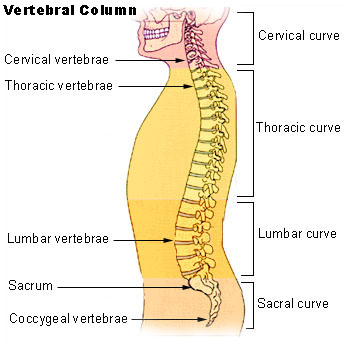We need to consider the form of the spine, its construction, if we are to eventually address two questions raised in the last note: what lengthens as we relax our weight, and how does the resulting separation of tissue promote health?
Accordingly, the next few posts will look at the various elements of the spine – the vertebral column as a whole, the individual vertebrae and the intervertebral discs, facet joints, spinal ligaments and thoracolumbar fascia. Take your time as you review these. Revisit them from time to time. Mulling over anatomy leads to unexpected insights into movement. And informs our understanding of the implications of illness.
Today, we will start with the spinal column. Lying as it does near the middle of the body, it acts as an articulated, central pillar about which the rest of the body drapes and moves. The centrality of the spine and its vital connections with every corner of the body is beautifully expressed in Robert Frost’s poem, The Silken Tent:
She is as in a field a silken tent
At midday when a sunny summer breeze
Has dried the dew and all its ropes relent,
So that in guys it gently sways at ease,
And its supporting central cedar pole,
That is its pinnacle to heavenward
And signifies the sureness of the soul,
Seems to owe naught to any single cord,
But strictly held by none, is loosely bound
By countless silken ties of love and thought
To everything on earth the compass round,
And only by one’s going slightly taut
In the capriciousness of summer air
Is of the slightest bondage made aware.¹
Made up of 24 small, mobile bones called vertebrae and 9 fused sacral and coccygeal vertebrae, the spine appears straight when viewed from the front or back. Only when we look from the side
do we see that there are 4 reciprocal curves:
- the cervical curve formed by the 7 cervical vertebrae. Concave posteriorly, it supports the head.
- the thoracic curve made up of 12 thoracic vertebrae. This curve is convex posteriorly, thus making room for the heart, lungs and great vessels that lie within the chest.
- the lumbar curve that lies fully in the centre of the abdominal cavity. It consists of 5 lumbar vertebrae and is concave posteriorly.
- the sacral curve formed by 5 fused sacral and 4 fused coccygeal vertebrae. Convex posteriorly, it provides space for the organs found in the pelvis.

Fig 1 The curves of the spinal column are visible when seen from the side. Netter, 2006, Plate 153
Although the sacral curve is fixed, the other three are dynamic and change shape as we alter our posture and movements. Their flexibility helps the spine resist compression along its vertical axis by allowing the soft tissues that lie along the convex side of each curve to stretch and absorb some of the force.
As you watch others practice this coming week, notice how the don yu and tor yu play with these curves.
A number of factors produce these normal curves: the shape of the vertebral bodies and discs, the pull of ligaments and muscles, and the orientation of the facet joints. Disease, trauma and aging can push these curves out of their normal shape. Alter the curves enough and you risk straining the soft tissues, bones and joints of the spine. You also threaten the function of the nerve roots exiting the spine and crowd the space available for our organs.
You will remember from earlier posts that the spine, along with the skull and ribs, forms the axial skeleton – that part of our anatomy that surrounds and creates the spaces known as the dorsal and ventral cavities.

Fig 2 The axial skeleton, the centre pole of the body, viewed from the back and depicted in blue. Neumann, 2010, page 308

Fig 3 The axial skeleton, again shown in blue, as it looks from the front. Neumann, 2010, page 308.
We have already seen that the dorsal cavity houses the sensitive nervous tissue of the brain and spinal cord – tissue essential to life. And it is the ventral cavity that provides room for the other, equally vital, organ systems of the body.

Fig 4 Organs of the chest, abdomen and pelvis all lie within the ventral cavity created by the spine, ribs, pelvis and the soft tissues of the abdominal wall. Netter, 2006, Plate 548

Fig 5 A picture with lots of detail. For now, just notice that this portion of the ventral cavity, bounded by the abdominal wall in front and the spinal column behind, is responsible for digestion, absorption of essential fluid and nutrients, reproduction and elimination. Netter, 2006, Plate 348
So, the spinal column, the centre pole about which the body is draped and moves. Constructed of many moving parts and capable of changing shape. Connected to all regions of the body.
With the next post, we turn to one of the building blocks of this column: the vertebrae and their discs.
¹ A Silken Tent taken from The Poetry of Robert Frost, Edward Connery Lathem, editor, 1942
² Kinesiology of the Musculoskeletal System, Foundations for Rehabilitation, Donald A. Neumann, Second Edition, 2010, Mosby Elsevier, ISBN 978-0-323-03989-5
³ Atlas of Human Anatomy, Frank H. Netter, 4th Edition, 2006, Saunders Elsevier, ISBN-13:978-1-4160-3385-1
© 2010 Taoist Tai Chi Society of Canada


